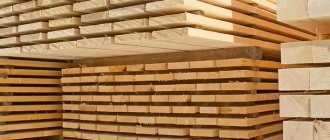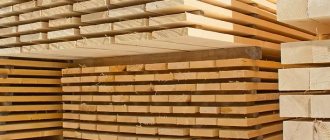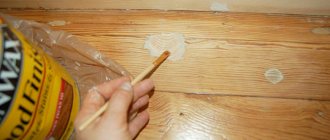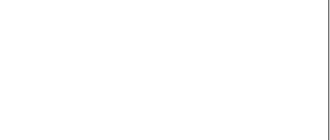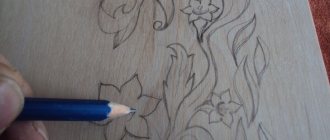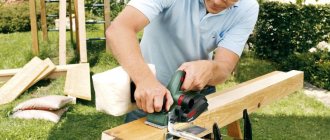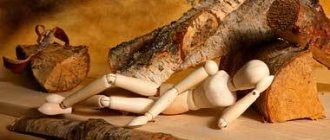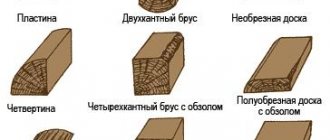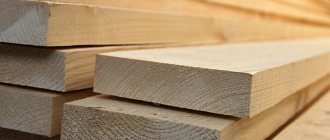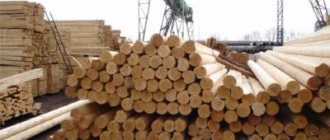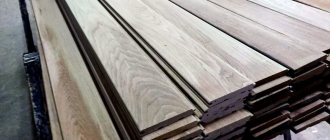Speaking of first-grade lumber, many imagine ideal boards “without a hitch,” so smooth that they can be used as a ruler on an industrial scale. Specialists working in the woodworking industry know that even the best quality boards or timber may have some flaws, and these are allowed by GOST. The grade of lumber, in fact, determines the permissible amount of a particular defect. Wane does not belong to the category of significant defects; rot or deep cracks along the entire length and width are much worse.
Types of wane
Before classifying the types of wane, let's figure out what it is. There is an opinion that this is uncleaned bark. In reality, the wane is the circumference of the log. Under certain conditions, the bark is either left on it or removed. Wane remains on the board or timber for a very understandable reason. A log, or round timber, has a round cross-section, while a board or timber has a square cross-section. In addition, the shape of the log is, in fact, a truncated cone, since in nature there are no trees that have an even trunk along its entire length. At sawmills, wood is treated with care, avoiding excess waste when sawing, which is why wane is left on some boards.
Wane is divided into two types: acute and blunt. A sharp wane occupies the entire area of the edge, while a blunt wane occupies only part of the surface or edge. According to GOST, edged boards can only have a blunt wane
, boards with sharp wane are classified as unedged. But on unedged boards the bark is always present; there is no point in removing it from the wane.
Types and features
Such a violation falls into the category of conditionally correctable violations, which is influenced by the area covered and the location. Therefore, depending on the location of concentration, such a flaw can be of several types. In general there are:
- sharp wane (runs across the entire width of the edge, which consists entirely of it);
- blunt wane (occupies only a certain portion of the area, remaining with a partial cut).
A clear example of the types of wane.
In addition, this defect can be present both on both edges (on both sides of the board) and on one of them. However, both types are used in everyday life, but it is necessary to take into account that in terms of strength they are significantly inferior to standard material.
Permissible amount of wane for edged boards
As we have already discussed above, edged boards of any kind, even selected ones, are allowed to have a blunt wane on one or two edges. Let us clarify that the presence of a blunt wane should be insignificant. According to the standards of GOST 8486, a first-grade edged board may have a wane on the face or edge along the entire length, if the width of the wane does not exceed 1/6 of the width of the face or edge. Let's explain with an example. Let's take a board 40x150x6.0 m. The permissible value for the wane with such board parameters will be no more than 6 mm for the edge and 25 mm for the face. In everyday life, such a wane is also called “pencil”
. If the wane occupies no more than 1/6 of the length of the board, the width of the wane is allowed to be 1/3 of the width of the edge or face. In our example, a board 40x150x6.0 m can have a wane of 12 mm and 50 mm for the edge and face, respectively, if the wane does not exceed a length of one meter.
For the convenience of customers, we offer a table with the values of wane acceptable according to GOST for first-grade edged boards. If there is more wane on the board, then either the grade of the lumber is reduced, or the board is transferred to the category of unedged lumber.
| Board size | Maximum wane length | Wane width at edge | Width of wane on the surface |
| 25x100x6000 | 6000 | No more than 4 mm | No more than 16 mm |
| 1000 | No more than 8 mm | No more than 33 mm | |
| 25x150x6000 | 6000 | No more than 4 mm | No more than 25 mm |
| 1000 | No more than 8 mm | No more than 50 mm | |
| 25x200x6000 | 6000 | No more than 4 mm | No more than 33 mm |
| 1000 | No more than 8 mm | No more than 66 mm | |
| 40x100x6000 | 6000 | No more than 6 mm | No more than 16 mm |
| 1000 | No more than 13 mm | No more than 33 mm | |
| 40x150x6000 | 6000 | No more than 6 mm | No more than 25 mm |
| 1000 | No more than 13 mm | No more than 50 mm | |
| 40x200x6000 | 6000 | No more than 6 mm | No more than 33 mm |
| 1000 | No more than 13 mm | No more than 66 mm | |
| 50x100x6000 | 6000 | No more than 8 mm | No more than 16 mm |
| 1000 | No more than 16 mm | No more than 33 mm | |
| 50x150x6000 | 6000 | No more than 8 mm | No more than 25 mm |
| 1000 | No more than 16 mm | No more than 50 mm | |
| 50x150x6000 | 6000 | No more than 8 mm | No more than 33 mm |
| 1000 | No more than 16 mm | No more than 66 mm |
How much does this affect quality?
Indeed, there is a tendency to reduce it - however, as with any other type of wood structure defects. Wane of wooden structures greatly reduces the strength of buildings and spoils their appearance, because the boards look like a different variety: somewhere thinner (due to hand sawing), somewhere thicker (in places of normal processing). As a result, these timber products require limited use.
Blunt wane on a board
Areas of use, assessment methods and methods for measuring defects are regulated by GOST 2140-81. It notes: if the edged material contains wood wane, then it is automatically classified as low-grade and ranked as the worst grade. Whereas in unedged there may be up to two such defects - at both ends (on opposite sides).
The scope of application of spoiled raw materials is limited to formwork, decking, scaffolding, subfloors, non-residential commercial buildings and any auxiliary structures.
Cinder board on the TISIZ sawmill
Based on all of the above, the presence of boards with a blunt wane does not mean that we are selling defective lumber or are trying to mislead buyers about the quality of the board or timber. Sawn boards are sorted very carefully, and when purchasing boards of the first grade, the client will not receive a board with a sharp wane or a dull one, but exceeding the permissible values. In addition, when placing an order at the TISIZ sawmill, the client can be sure that he will receive lumber of exactly the same quality as he saw at the sawmill when placing the order. At the same time, no one forbids the client to be present when the order is loaded before shipment and, if he is not satisfied with the quality of the shipped lumber, to refuse it. In this case, we return the money paid by the client without any problems.
Types of ash lumber
Boards with conditional (removable) defects are divided into two categories.
- Unedged wane lumber is obtained through longitudinal cutting of raw logs. The technology involves minimal production costs, which explains the low price level of building materials.
- Edged boards are produced by cutting a processed tree trunk. In this case, a certain percentage of wane remains. This lumber is of higher quality, which is reflected in its cost.
Types of wane
- Blunt. Occupies only part of the side surface of the board. In everyday life it is called pencil.
- Spicy. Almost completely covers the edge. The disadvantage of such boards is that the finished container can violate the integrity of the cargo packaging.
According to GOST, edged lumber can only have a blunt type of defect; workpieces with a sharp wane are equal to unedged ones.
Moisture set
Warehouses are different:
Some are heated and some are cold.
At trading bases, as a rule, the latter predominate.
It's no secret that seasons such as spring and autumn are characterized by high humidity, which is facilitated by precipitation in the form of rain and sleet.
Laminated chipboard is made from sawdust, and wood, as you know, absorbs moisture very well. And having collected moisture, the wood begins to swell, which leads to an increase in the thickness of the slab at the edges.
And even though the packs are packaged and covered with packing sheets, some of the moisture will still naturally get to the ends during storage or during loading and unloading operations. No one is immune from this.
Also, you should not have any illusions that a material such as plywood is not at all afraid of moisture - even when stored in bundles, it swells slightly (of course, this is not as noticeable as on laminated chipboard), and even darkens/yellows.
It would seem that a slight increase in thickness due to the reasons described above is a minor issue and invisible to the eye. But in practice this can lead to several nuances:
- When cutting along the cut line, noticeable and rather unpleasant chips may appear on parts located close to the edge of the sheet.
2. Even if you are lucky and the cutting goes smoothly, problems may arise at the time of applying the edge to the part, since the thickness of the slab in the machines is monitored by copiers. They, in turn, are located at some distance from the end of the part. And most often in such situations, the following happens - at the place where the copier passes, the thickness of the material is 16.12 mm, and directly at the end where the edge is applied, the plate is slightly swollen and is already 16.43. In this case, there is a very high probability that part of the laminate will simply be cut off when processing the overhangs of the edge material.
Cinder board - where to buy and what is it for?
Many people mistakenly believe that wane on a board is a significant defect. But in fact, this is not always the case and depends on several parameters. Today Jack Lambert will tell you what a wane board is, and when you shouldn’t worry about a wane board.
First, it’s worth understanding what wane is. It’s written about in our directory, but I’ll try to explain it more simply. Firstly, it is a very common opinion that wane is the remainder of the bark on the board, but this is not so, there may be no bark, but the wane may remain. Because the wane is the round surface of the log, which partially remains on the board. The appearance of wane is due to the fact that the log has the shape of a truncated cone and a round cross-section, and the board has a square cross-section, so if you “fit” the board into the log, there will either be large losses of wood when cutting out a clean board, or some boards will have wane. In this case, the bark can be removed.
As it is not difficult to notice, the wane reduces the cross-section of the board, which can negatively affect the strength. However, slight wane has virtually no effect on strength. If we turn to GOST 8486, then even in the highest grades of lumber, such as selected, first grade and second, wane is allowed. However, there are some caveats. First of all, only a blunt wane is acceptable - that is, the round surface extends only over part of the edge and part of the surface. Sharp wane, when the edge is completely unsawed, is not allowed. Its overall size is also regulated. If the wane reaches 1/6 of the edge or face, then its length is not regulated - it can run along the entire length of the board. This type of wane is also called a pencil wane. However, it is not tied to the size of the pencil, and will be different for each thickness and width of the board. In addition, wane is allowed up to 1/3 of the width of the edge or face for a length of up to 1/6 of the board. For example, on a business board 25x100x6000, a continuous wane of up to 16 mm on the face and up to 4 mm on the edge with sections 1 m long, where the wane can be up to 33 mm on the face and 8 mm on the edge, will be acceptable. For a business board 50x150x6000 these figures will already be 25 mm and 8 mm without length restrictions and 50 mm and 16 mm for a length of up to 1 meter. And for commercial timber 200x200x6000, a wane of 33 mm without length limitation and 66 mm in meter-long sections is completely acceptable.
But it also happens that there is more wane. In this case, the board is either converted to unedged while maintaining the grade or its grade is lowered. In this case, a board with a large amount of wane is called a wane board. Such a board costs less than a business board and is usually used for the construction of temporary structures, scaffolding, decking or formwork. Cinder board is often called “construction board” because it is most often used on construction sites. At the same time, the construction board has three sawn sides, which allows it to be used for most tasks.
Thus, wane is not a very strong defect. And in many cases, a ash board will be preferable - you practically do not lose in quality, but at the same time you gain a lot in price. And in some cases, ash or unedged boards are taken specifically to create interesting design solutions. At the Jack Lambert Sawmill you can always buy both business and ash boards. We also deliver boards throughout St. Petersburg and the Leningrad region by on-board vehicles or manipulators.
